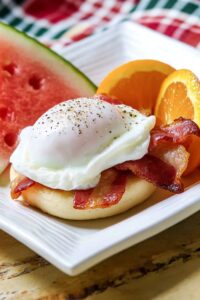Description
Julia Child’s classic French poached eggs bring elegant simplicity to breakfast tables. Her masterful technique creates silky eggs with perfectly runny centers, delivering a luxurious morning experience that elevates your culinary skills with Parisian charm.
Ingredients
Scale
Main Ingredients:
- 1 large egg
Liquid Ingredients:
- 1 tablespoon (15 milliliters) white vinegar
Dry Ingredients:
- No dry ingredients in this recipe
Instructions
- Prepare the cooking vessel by filling a generously sized pot with approximately 7.5 centimeters (3 inches) of fresh, cool water, ensuring ample space for the poaching process.
- Elevate the water temperature to a robust boil using high heat, then gracefully reduce to a gentle simmer where tiny bubbles nestle at the pot’s bottom without disrupting the surface.
- Delicately crack the egg into a fine-mesh strainer to eliminate loose, watery egg whites, then transfer the refined egg into a small ceramic ramekin or shallow bowl.
- Introduce a splash of white vinegar (approximately 1 tablespoon or 15 milliliters) into the simmering water, which helps coagulate the egg proteins and create a more compact poached egg.
- Generate a gentle whirlpool by rotating a long-handled spoon in a circular motion through the water’s center, creating a smooth vortex that will help wrap the egg white around the yolk.
- Gently slide the egg from the ramekin directly into the water’s swirling center, allowing the current to naturally envelop and shape the egg.
- Allow the egg to poach undisturbed for approximately 2.5 to 3 minutes, watching for the egg white to transform from translucent to opaque and set while maintaining a luxuriously soft, runny golden yolk.
- Retrieve the poached egg using a perforated spoon, letting excess water drain briefly, then transfer to a layer of absorbent paper towel to remove any remaining moisture before serving.
Notes
- Poaching eggs seems tricky, but mastering a few simple techniques makes it surprisingly easy and rewarding.
- White vinegar acts like magic glue, helping egg whites coagulate beautifully without changing the delicate flavor.
- Gentle water movement creates a perfect vortex that elegantly wraps egg whites around the golden yolk.
- Room temperature eggs perform better than cold ones, spreading more evenly and poaching more consistently.
- Timing matters critically – three minutes delivers a dreamy runny center with perfectly set whites.
- Freshest eggs guarantee the most stunning poached results, with compact whites that stay beautifully together.
- Shallow simmering water prevents aggressive boiling that could tear delicate egg structures apart.
- Strain watery egg whites before poaching to ensure a cleaner, more professional-looking final presentation.
- Using a fine mesh strainer helps remove loose egg whites, creating a neater, more compact poached egg.
- Salt the water after poaching to prevent potential protein breakdown during the cooking process.
- Prep Time: 5 minutes
- Cook Time: 3 minutes
- Category: Breakfast, Snacks
- Method: Poaching
- Cuisine: American
Nutrition
- Serving Size: 1
- Calories: 70 kcal
- Sugar: 0 g
- Sodium: 5 mg
- Fat: 5 g
- Saturated Fat: 1.5 g
- Unsaturated Fat: 3.5 g
- Trans Fat: 0 g
- Carbohydrates: 1 g
- Fiber: 0 g
- Protein: 6 g
- Cholesterol: 186 mg
